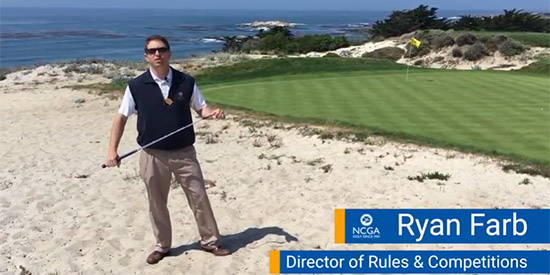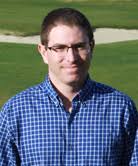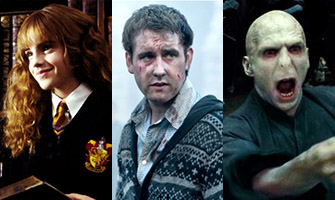
Ryan Farb has been in Pebble Beach for 11 years (YouTube screen shot)
A competitor's tee shot on a par-3 hole comes to rest in a bunker short of the green. He picks up a leaf that was affecting his lie and in the process the ball moves. While waiting for his fellow competitor to play his next shot, the leaf that he had removed has blown back and is behind his ball. The competitor takes his backswing and touches the same leaf. He stops his swing and decides to deem the ball unplayable. He lifts his ball, rakes the bunker and decides to play his next shot from the tee. His next shot lands on the putting green and he two-putts. What is his score for the hole?*

|
- NCGA photo
|
Ryan Farb knows the answer (it is 11, although with the upcoming rules changes in 2019, the answer will also change).
The Director of Rules and Competitions at the Northern California Golf Association (NCGA) has become one of the foremost experts on the Rules of Golf, and has completed a quest that most never will: He has achieved a perfect score on the USGA Rules Exam, where knowledge of both the meaning of every word and the intention of every rule must be deeply ingrained to procure a good score.
The soon-to-be 34-year-old contributes regular
Know Your Rules articles and rules quizzes for the NCGA, and his
Farb Talk blog dives deep into the Rules with theoretical and real-world analysis and resources for would-be rules officials.
Farb has parlayed his extensive knowledge of the Rules into referee assignments at a long list of important tournaments, including USGA championships, professional events and qualifiers, collegiate events, and amateur tournaments for every ability level and in every format.
He runs a full slate of championships at one of the busiest golf associations in the country, and has used his experience to refine his approach to site selection, course setup and the one factor that haunts tournament directors more than any other: pace of play.
As it has been since 2007 when he arrived as an assistant golf pro, his office is at Poppy Hills Golf Club on the idyllic Monterey Peninsula, whose neighbors include Pebble Beach, Cypress Point and Spyglass Hill.
Farb grew up in Tucson, Ariz., before heading east to study Classical Culture at the University of Georgia, and though his major hasn't carried over, his love of college football has (his Dawgs are ranked No. 5 as of the time of this interview). That, and his fervor for all things
Harry Potter.
A former Northern California PGA Assistant Professional of the Year, Farb is now a reinstated amateur, finding competition in the rare breaks in the NCGA tournament schedule. He is no stranger to high-level amateur competition; among the tournaments he competed in before turning professional are the U.S. Junior, the North & South Amateur and the Arizona Open.
Part 1: Short Answer
Age when you started playing golf: 5
Number of tournaments you have run or officiated in the last calendar year: 26
Number of tournaments in which you have competed in the last calendar year: 4
Favorite course to play: Pacific Dunes
Favorite course to set up for competition: Spyglass Hill
Favorite tournament to work: That’s tough. It kind of changes each year, but the men’s Pac-12, US Women’s Four-Ball and US Girls’ Junior are up there when I work them. I love the NCGA Amateur Match Play but the week is just a grind for me. There’s more than one reason that what little vacation I take follows our match play.
# of times making 100 on the USGA Rules Exam: 2
The percentage of PGA Tour pros who would pass the USGA Rules Exam: More than you’d think, 75% maybe
If you were to take all of the rulings you have ever given, which single Rule of Golf came into play the most often? 18-2: Ball at Rest Moved by Player

|
Which Harry Potter character is Ryan Farb?
Depends who you ask...
|
Which Harry Potter character are you? Well this isn’t a short answer for me… I’d probably say Hermione, a little bit know-it-all, over prepared, a little neurotic and a bookworm. Friends would probably say Neville, nerdy, clumsy but will come through in the end. And anyone who faces my semi-final setup of our Amateur Match Play thinks I’m Voldemort…
Part 2: Open Answer
What are the best and least best parts of your job?
We get to work some incredible places and I’ve been able to play or access courses that were only a pipe-dream growing up. The people we work with, staff and volunteers are incredible. Golf is a game that, on a competitive level, would collapse entirely without the devoted volunteers (officials, marshals, and numerous other capacities that make major events run) and our officials never cease to amaze me.
But even though it’s not the toughest job, and after all it’s not life or death, I spend a lot of time away from home and work very long, abnormal hours. There’s a period of burnout every year, some years worse than others. This time of year, even when the road trips have started to slow down, finalizing our calendar drives me absolutely bonkers. Whether it’s phone calls or emails that go without response, last minute surprises or finding out an outside major championship has decided to use dates on top of our own major championship, the latter months of the process are grueling. I don’t think many people realize how many factors go into setting a calendar like ours and there is literally no way to make it perfect for everyone.
What do you think is the single biggest misconception that players have about rules officials?
Players think we’re there to referee like NFL or NBA refs – call penalties. But we’re there to help, to assist. Golf is unique because its Rules have to apply to an infinite variety of playing fields and even the simplest situations can be complicated to get right. We’re around to help players get it right and get to the best possible result. Yes, sometimes we have to call penalties for actions that seem harmless, but more often we’re helping a player get out of jail under an option they didn’t know they had.
When rules officials get together and tell stories of interesting rulings or player mishaps, what story do you tell?
We’re always trying to tell stories about the event we’re at. Otherwise we’d tell the same ones over and over. One that comes up more often for me though, is a stretch in 2015 that ended with a rare occurrence in the Senior Open. In a span of seven tournament rounds, I had golf balls collide on the putting green after strokes from the fairway or off the green five times as a walking referee (including twice in four holes one round). The ruling is easy – the player whose ball was at rest replaces the ball and the other player plays the ball as it lies. But determining where the moved ball needs to go back to is not always easy.
In the 2015 Senior Open, my group consisted of Olin Browne, John Riegger and P.H. Horgan. On the 16th hole at Del Paso, a real beast of a par 4 at 470 yards over water on the second shot, Horgan’s second shot from 200 yards or so out collided with Browne’s ball at rest on the green. The forward observer was 50 yards away so he didn’t have a great view. We had to consult a spectator in the stands next to the green to get the moved ball back in the right spot. After the hole was over, Browne was still unsure we got the ball in the right spot and seemingly a little upset – I’m not sure why, his ball hadn’t moved more than a yard – so we had to talk through it until I convinced him his ball was replaced at the correct spot.
What is it like to try to maintain your game given your work schedule, and what are your playing goals?
There is no maintaining my game. Fortunately, I’m a feel player with an ugly but effective swing and I can get up and down out of a garbage can, so if I have an event coming up I play a few 9-hole rounds after work to get my feel back. It’s usually good enough to get the ball around, but I’m still lacking tournament reps to get rid of the nerves and my putting is atrocious. However, it felt really good this year in the SF City to bounce back from an 80 at Harding [Park] to a 68 at Lincoln [Park] to make match play as a middle-seed.
I regained my amateur status specifically because I want to get back to a USGA Championship. I was working the US Four-Ball at Winged Foot in 2016 when it dawned on me that (1) there was no longer a benefit for me to be a professional, (2) there were more playing opportunities for me as an amateur and (3) I’m not qualifying for the Open so if I want to get to a USGA event, it has to be the Am, Mid-Am or Four-Ball.
What is the most important thing for you to get "right" when it comes to a championship course setup?
When I do site visits, people think we’re looking for the hardest hole locations. That’s just not the case. In each round, I’m looking for a tough, but fair test that matches the level of the field and the types of players (whether we like it or not, you can tuck more holes with scratch men than scratch women, net players just can’t handle a real championship setup and some courses just aren’t designed to maintain green speeds that players or, ahem, coaches, want to see). But in my setups, I look for as balanced a test of left, right middle, front, middle back and easy, medium, hard. In the end, I want to see the best players rise to the top.
But to actually answer the question, the most important thing for me is to not go overboard. The setup, as important as it is to me and as much time as I spend on it, should not be the story. If you’ve put a hole out there that becomes the headline due to your setup and not just because it’s an amazing hole (17 at St. Andrews, 18 at Carnoustie, 16 at Turnberry, 11 or 12 at Augusta), a mistake has been made. I once set a hole location that was fine when I chose it, but the green speeds gained about 2 feet between my selection and the round in question. Someone who we now know as one of the best in the world that played in the Ryder Cup made a 9 (it was a par 3). His coach was not happy, but frankly, neither was I.
When conducting a golf tournament, what do you do to ensure the best possible pace of play? What are the most important things to avoid?
It depends on the event, because the most important factors are not always in my control. When I have control over all aspects, I ensure we have the proper field size and use the proper starting intervals. These are the two most important factors (besides having a pace policy that can be enforced) to having good pace of play. If you have the choice: (1) Groups of 3 over groups of 4, (2) Absolutely no more than 84 in a wave (preferably 78) for groups of 3 and no more than 96 for groups of 4, and (3) 11 minute intervals (12 in groups of four if you have a single tee start).
If your event is set up with more players or smaller intervals than those guidelines, on an average championship setup you have no chance of a decent pace of play. I know someone is going to read this and say codswallop, but I’ve done a lot of research and study on the topic: if you get good pace of play with over-sized waves or 9 minute intervals or less – you got lucky.
There are also some little things in setup that can help or hurt you: drivable par 4’s are fun, but they have to be at the right spot; if your first hole is a par 5, think about setting it up one of two ways: (1) shorten it to a long par 4, it will help you get off the tee on time, or (2) set it up so that it needs to be played as a 3-shotter; don’t set up a par 3 to be really difficult right after a short, easy par 4, you’ll end up with 2-3 groups on the par-3 tee. Oh, and if you have a known slow-player in the field, put them in the last group or a group of two when you have a choice.
What is the most unusual excuse a player has ever given you for running afoul of a Rule of Golf?
I haven’t gotten any unusual excuses, but frequently get the “I didn’t know”, “I didn’t mean to” or “I didn’t get an advantage from it.”
Nearly every state golf association in the country hosts its championships at courses throughout the state. But the NCGA hosts 27 of its 30 or so championships at one of three courses (Poppy Hills, Spyglass Hill, Poppy Ridge). With so many potential championship venues in Northern California, what is the philosophy behind having such a small number of host venues?
There are a number of factors. We’re in a unique situation owning one of the best properties in northern California. To not use it as a championship site would be as big a mistake as using it too much. With Spyglass, we have another unique situation that allows us to use yet another one of the best tracks in the country, if not the world, for 10 days for championships. We also run more championships than most associations because we’re a year-round area and an extremely large association.
Believe it or not, courses are not lining up to host multi-day championships and most certainly not for a rate that we can afford. There aren’t really even that many places we could actually ask on an annual basis that would provide the same quality test we get out of Hills or Spy. We’re very lucky to have some great courses in our area, including some that will host our majors once or twice in a six year span. But honestly, finding the USGA qualifying sites and remaining championship sites for our events is the bane of my existence every year from July-November as it is (see my earlier answer!). I’m not at liberty to discuss my future planning, but there will come a day when we have to look at incorporating more venues in our championship rota.
What is the most significant or best rule change to come in 2019 and why?
For all intents and purposes, the dissolution of current Rule 13-4. In 2019, you can remove loose impediments from penalty areas and bunkers, and in penalty areas you can ground your club and test the condition. In bunkers you can ground your club away from the ball, so all in all a number of silly penalties go away. Along that line, removing the penalty for accidental deflections throughout the Rules is a brilliant change. As explained by the USGA, most of these deflections are actually to the detriment of the player and are completely unintentional. To add a penalty on top of those, or to complicate the situation (as in the case of striking an opponent or their equipment/caddie), just isn’t necessary in the modern game. It adds a consistency that was lacking: if your ball gets deflected and no one meant to do it, play hard (and of course because it’s a good Rule, there is an exception or two to that).
Without getting into almost impossible scenarios, how many different ways can you think of for a player to score a 2 with a penalty stroke?
- If a player hits his/her tee shot on a par-3 hole and it comes to rest overhanging the hole, if, after arriving at the hole, the player waits more than 10 seconds and then the ball falls into the hole, it is technically a 2 with a one-stroke penalty
- In 2019, along the same lines, the first breach of unreasonable delay could result in a 2 with a penalty if the player was guilty of unreasonable delay during the hole, but made a hole-in-one
- One that I know has happened, if the pace of play policy applies a one-stroke penalty for a breach (whether first or second), if the player breaches the policy but makes a hole-in-one on the hole, it’s a 2 with a penalty.
- If a player hits his/her tee shot on a par-3 hole and it comes to rest on the fringe, on a slope above the hole, if the player takes any number of actions that result in a one-stroke penalty, and the ball is subsequently moved by wind or gravity and rolls into the hole, it's a 2 with a penalty.**
* The rules scenario at the top of this article was taken from the Metropolitan Golf Association Rules Quiz
** Actions resulting in a one-stroke penalty include: ball at rest moved by player (18-2), cleaning the ball (21), lifting ball when play discontinued (6-8c), ball unfit for play procedure (5-3), identifying ball procedure (12-2), and other actions involving the procedure for lifting, marking, dropping or replacing (20).